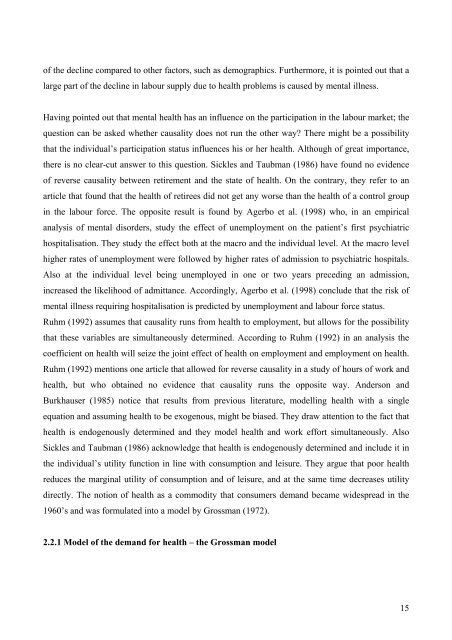An Analysis on Danish Micro Data - School of Economics and ...
An Analysis on Danish Micro Data - School of Economics and ...
An Analysis on Danish Micro Data - School of Economics and ...
You also want an ePaper? Increase the reach of your titles
YUMPU automatically turns print PDFs into web optimized ePapers that Google loves.
<strong>of</strong> the decline compared to other factors, such as demographics. Furthermore, it is pointed out that a<br />
large part <strong>of</strong> the decline in labour supply due to health problems is caused by mental illness.<br />
Having pointed out that mental health has an influence <strong>on</strong> the participati<strong>on</strong> in the labour market; the<br />
questi<strong>on</strong> can be asked whether causality does not run the other way? There might be a possibility<br />
that the individual’s participati<strong>on</strong> status influences his or her health. Although <strong>of</strong> great importance,<br />
there is no clear-cut answer to this questi<strong>on</strong>. Sickles <strong>and</strong> Taubman (1986) have found no evidence<br />
<strong>of</strong> reverse causality between retirement <strong>and</strong> the state <strong>of</strong> health. On the c<strong>on</strong>trary, they refer to an<br />
article that found that the health <strong>of</strong> retirees did not get any worse than the health <strong>of</strong> a c<strong>on</strong>trol group<br />
in the labour force. The opposite result is found by Agerbo et al. (1998) who, in an empirical<br />
analysis <strong>of</strong> mental disorders, study the effect <strong>of</strong> unemployment <strong>on</strong> the patient’s first psychiatric<br />
hospitalisati<strong>on</strong>. They study the effect both at the macro <strong>and</strong> the individual level. At the macro level<br />
higher rates <strong>of</strong> unemployment were followed by higher rates <strong>of</strong> admissi<strong>on</strong> to psychiatric hospitals.<br />
Also at the individual level being unemployed in <strong>on</strong>e or two years preceding an admissi<strong>on</strong>,<br />
increased the likelihood <strong>of</strong> admittance. Accordingly, Agerbo et al. (1998) c<strong>on</strong>clude that the risk <strong>of</strong><br />
mental illness requiring hospitalisati<strong>on</strong> is predicted by unemployment <strong>and</strong> labour force status.<br />
Ruhm (1992) assumes that causality runs from health to employment, but allows for the possibility<br />
that these variables are simultaneously determined. According to Ruhm (1992) in an analysis the<br />
coefficient <strong>on</strong> health will seize the joint effect <strong>of</strong> health <strong>on</strong> employment <strong>and</strong> employment <strong>on</strong> health.<br />
Ruhm (1992) menti<strong>on</strong>s <strong>on</strong>e article that allowed for reverse causality in a study <strong>of</strong> hours <strong>of</strong> work <strong>and</strong><br />
health, but who obtained no evidence that causality runs the opposite way. <str<strong>on</strong>g>An</str<strong>on</strong>g>ders<strong>on</strong> <strong>and</strong><br />
Burkhauser (1985) notice that results from previous literature, modelling health with a single<br />
equati<strong>on</strong> <strong>and</strong> assuming health to be exogenous, might be biased. They draw attenti<strong>on</strong> to the fact that<br />
health is endogenously determined <strong>and</strong> they model health <strong>and</strong> work effort simultaneously. Also<br />
Sickles <strong>and</strong> Taubman (1986) acknowledge that health is endogenously determined <strong>and</strong> include it in<br />
the individual’s utility functi<strong>on</strong> in line with c<strong>on</strong>sumpti<strong>on</strong> <strong>and</strong> leisure. They argue that poor health<br />
reduces the marginal utility <strong>of</strong> c<strong>on</strong>sumpti<strong>on</strong> <strong>and</strong> <strong>of</strong> leisure, <strong>and</strong> at the same time decreases utility<br />
directly. The noti<strong>on</strong> <strong>of</strong> health as a commodity that c<strong>on</strong>sumers dem<strong>and</strong> became widespread in the<br />
1960’s <strong>and</strong> was formulated into a model by Grossman (1972).<br />
2.2.1 Model <strong>of</strong> the dem<strong>and</strong> for health – the Grossman model<br />
15
















